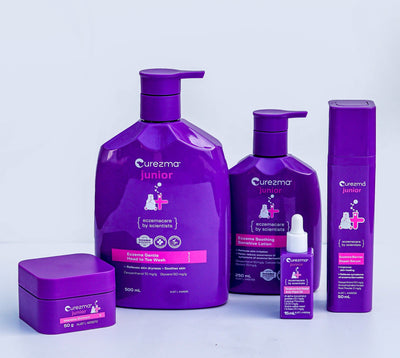
Ingredient Glossary
Learn about the powerful ingredients that make up the Curezma skincare range. Our ingredient glossary provides in-depth information about each ingredient we use and its unique benefits for eczema-prone skin.
Function: Biosaccharide gum-1 is a polysaccharide compound with smoothing, moisturizing, anti-aging, and immunosurveillance boosting properties
Function: α-Bisabolol is the naturally occurring form of Bisabolol. It is known to have anti-irritant, anti-inflammatory, and antimicrobial properties.
Function: Ceramide 3, also known as Ceramide NP, is a major component of the lipid matrix holding the skin cells in the skin barrier together. Deficiency in Ceramide 3 has been linked to higher TEWL levels and people with eczema tend to have reduced levels of Ceramide 3.
Function: Coconut oil has been shown to have antimicrobial and anti-inflammatory properties. It is high in medium chain fatty acids, of which lauric acid comprises about 50%. The body converts lauric acid into monolaurin, which is an antimicrobial agent. Coconut oil contains antioxidants which help to reduce unnecessary inflammatory responses. It is also quickly absorbed into the skin and acts as an emollient to soften and smoothen the skin while providing some hydration benefits.
Function: A silicone compound that is used to improve the feel of the product while providing emollient properties and a protective barrier over the skin.
Function: This is a hypoallergenic and non-comedogenic surfactant. It has good foaming and solubilizing properties to clean the skin while minimizing disruption to the skin barrier.
Function: Evening Primrose Oil is a natural plant oil high in linoleic acid, a fatty acid that is helpful for maintaining the skin barrier. It acts as an emollient and provides anti-irritation and soothing benefits.
Function: Flaxseed Oil is rich in alpha-linolenic acids, a type of omega-3 fatty acid. It has good emollient properties as linoleic acid has been shown to help the skin barrier function.
Function: Glycerin is a well-known molecule for its humectant properties. It is used to give additional hydration benefits to the skin.
Function: Glycyrrhetinic Acid is a terpene compound derived from licorice root. It has been shown to have anti-inflammatory, anti-itching, antioxidant, and antimicrobial properties. Furthermore, it has been shown to improve cell turnover, which helps in the treatment of wounds and other skindefects. Glycyrrhetinic Acid is similar in structure to hydrocortisone (a type of steroid) and has been shown to have similar properties. It has been shown to reduce the conversion of the naturally occurring hydrocortisone in the body to its inactive form making the hydrocortisone more effective and reducing the negative effects of steroid overapplication.
Function: A high molecular weight hyaluronic acid that stays on the surface of the skin and acts as a humectant to help hydrate the skin.
Function: Konjac Mannan Gel is a polysaccharide made from the tuber of Konjac. Similar to hyaluronic acid, it helps hydrate the skin through its humectant (water retaining) properties.
Function: Olivem is a PEG-free emulsifier naturally derived from olives with a similar lipid profile to the skin's surface. It has the ability to generate emulsion structures that mimic how the skin barrier is organized so that the emulsion integrates into the skin better and doesn't disrupt the skin barrier.
Function: Other than acting as an emollient like most oils, rosehip oil also contains high levels of vitamin C, transretinoic acid, and polyunsaturated fatty acids. These compounds contribute to rosehip oil having antioxidant and anti-inflammatory properties.
Function: Shea Butter has antioxidant and anti-inflammatory properties as well as acts as a fast absorbing emollient to help smoothen the skin and provide a protective barrier.
Function: This is a mild and gentle surfactant. It has good foaming and solubilizing properties to clean the skin while minimizing disruption to the skin barrier.
Function: Sodium Phytate is a natural chelating agent used as a substitute for other chelating agents like EDTA. It also acts synergistically with antioxidants.
Function: Sunflower Oil is high in linoleic acid, which helps to maintain the skin barrier. As an oil, sunflower oil also has natural emollient properties while containing some compounds that provide antioxidant and anti-inflammatory properties. Sunflower oil has also been shown to be able to stimulate the body`s natural production of ceramides, which can help with skin barrier function and reduction of skin inflammation.
Function: Tamanu Oil is derived from the Tamanu Tree and has shown to have bioactive properties such as antioxidant, anti-inflammatory, antibacterial, wound healing, and other properties. These have mostly been attributed to the resinous compounds in addition to the natural fatty acids found in oils that give them emollient properties.
Function: Vegelatum Castor is a mineral oil-free alternative to petrolatum. It uses an organogel structure to create an oily gel to provide a stronger occlusive layer on top of the skin.
Function: Vitamin E that is naturally sourced so that it is bioavailable in the body. It acts as an antioxidant to preserve oils and to reduce unnecessary inflammatory response in the skin.
Function: Yogurtene Balance CQ is a blend of Inulin and Yogurt Powder. Inulin is a vegetable fructose polysaccharide while Yogurt Powder is full of nutrients like non-hydrolyzed proteins, lactose, vitamins, and minerals. Together they act as a prebiotic to promote the growth of good bacteria while reducing harmful bacteria on the skin.





